Supply Chain Management Report: Analysis of Toyota's Operations
VerifiedAdded on 2023/01/13
|14
|3378
|55
Report
AI Summary
This report provides a comprehensive analysis of Toyota's supply chain management. It begins with an executive summary and table of contents, followed by an introduction to the competitive business landscape and the importance of effective supply chain management. The report then delves into Toyota's material management approach, emphasizing its centralized nature and benefits like economies of scale and quality control. The supply chain structure is examined, highlighting the integrated make-to-stock model and the role of intermediaries. The advantages of lean and agile practices, such as reduced inventory and increased flexibility, are discussed. The significance of relationships in material management and reverse logistics, including the use of contracts and outsourcing, is explored. Finally, the report addresses opportunities arising from green supply chain processes and concludes by summarizing the key findings and offering recommendations for Toyota's supply chain management strategies.
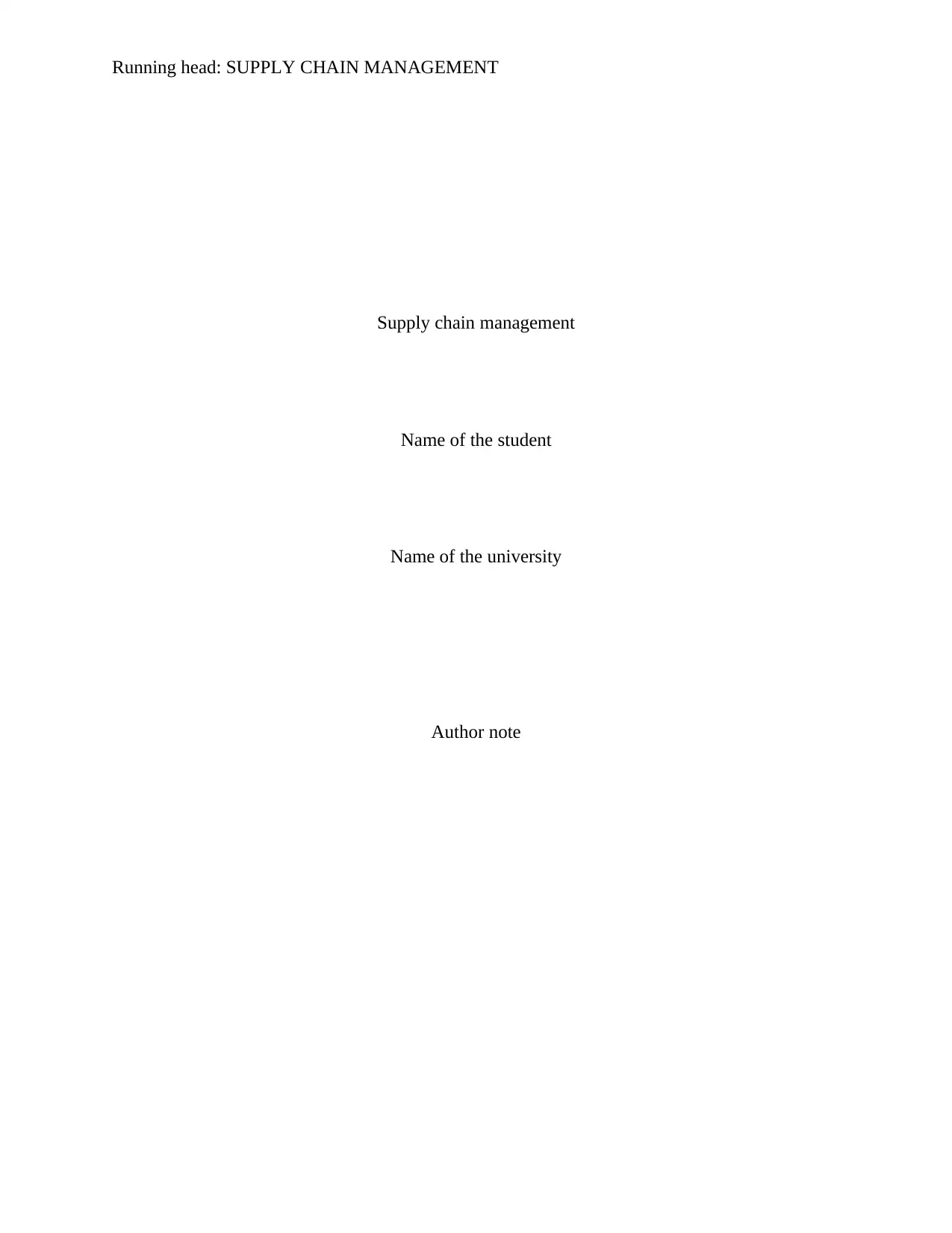
Running head: SUPPLY CHAIN MANAGEMENT
Supply chain management
Name of the student
Name of the university
Author note
Supply chain management
Name of the student
Name of the university
Author note
Paraphrase This Document
Need a fresh take? Get an instant paraphrase of this document with our AI Paraphraser
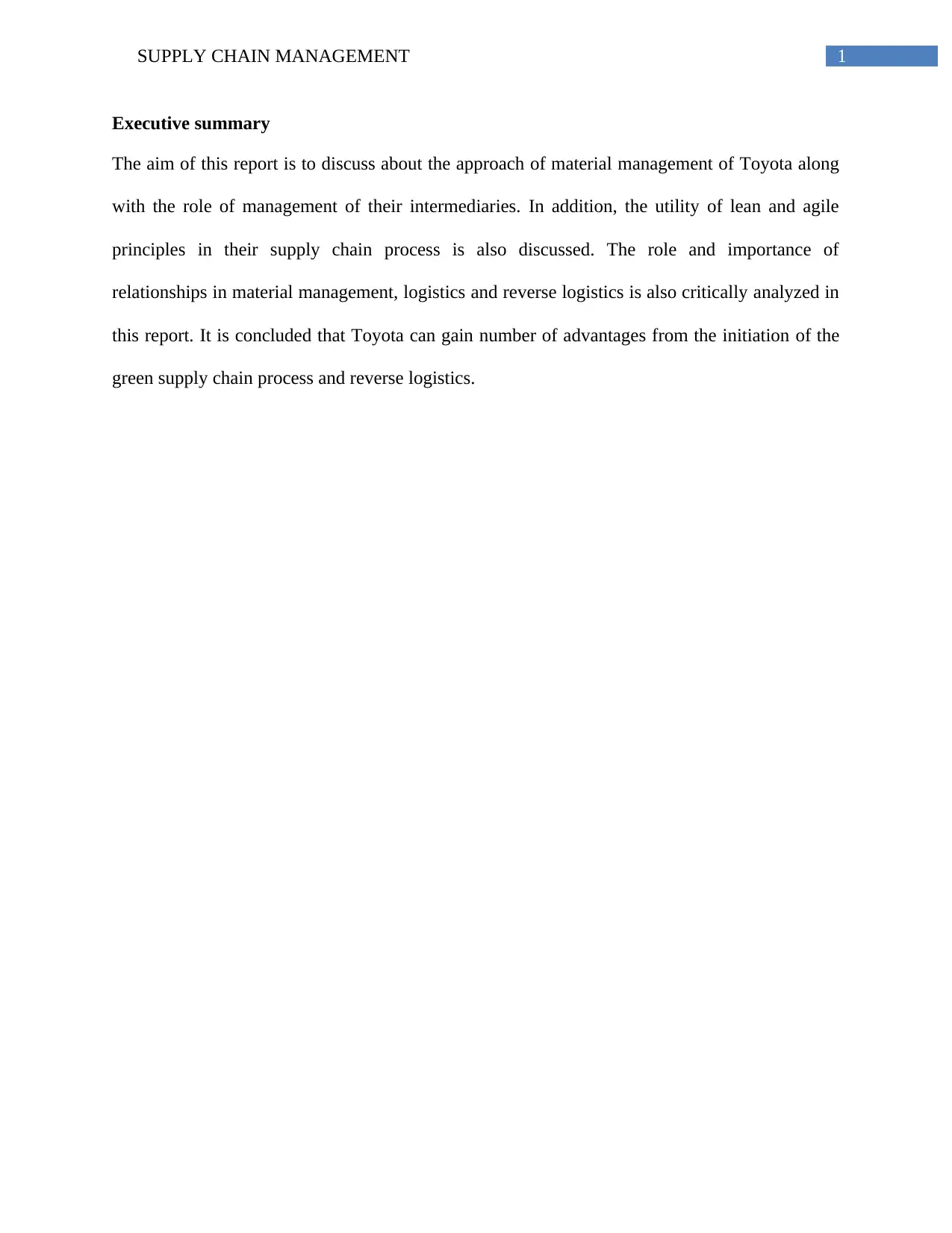
1SUPPLY CHAIN MANAGEMENT
Executive summary
The aim of this report is to discuss about the approach of material management of Toyota along
with the role of management of their intermediaries. In addition, the utility of lean and agile
principles in their supply chain process is also discussed. The role and importance of
relationships in material management, logistics and reverse logistics is also critically analyzed in
this report. It is concluded that Toyota can gain number of advantages from the initiation of the
green supply chain process and reverse logistics.
Executive summary
The aim of this report is to discuss about the approach of material management of Toyota along
with the role of management of their intermediaries. In addition, the utility of lean and agile
principles in their supply chain process is also discussed. The role and importance of
relationships in material management, logistics and reverse logistics is also critically analyzed in
this report. It is concluded that Toyota can gain number of advantages from the initiation of the
green supply chain process and reverse logistics.

2SUPPLY CHAIN MANAGEMENT
Table of Contents
Introduction......................................................................................................................................3
Material management of Toyota......................................................................................................4
Supply chain structure of Toyota.....................................................................................................5
Advantages of lean and agile practices............................................................................................6
Role of relationships in material management................................................................................7
Role of relationship in reverse logistics...........................................................................................8
Opportunities from green supply chain process..............................................................................8
Conclusion.....................................................................................................................................10
Reference.......................................................................................................................................11
Table of Contents
Introduction......................................................................................................................................3
Material management of Toyota......................................................................................................4
Supply chain structure of Toyota.....................................................................................................5
Advantages of lean and agile practices............................................................................................6
Role of relationships in material management................................................................................7
Role of relationship in reverse logistics...........................................................................................8
Opportunities from green supply chain process..............................................................................8
Conclusion.....................................................................................................................................10
Reference.......................................................................................................................................11
⊘ This is a preview!⊘
Do you want full access?
Subscribe today to unlock all pages.

Trusted by 1+ million students worldwide
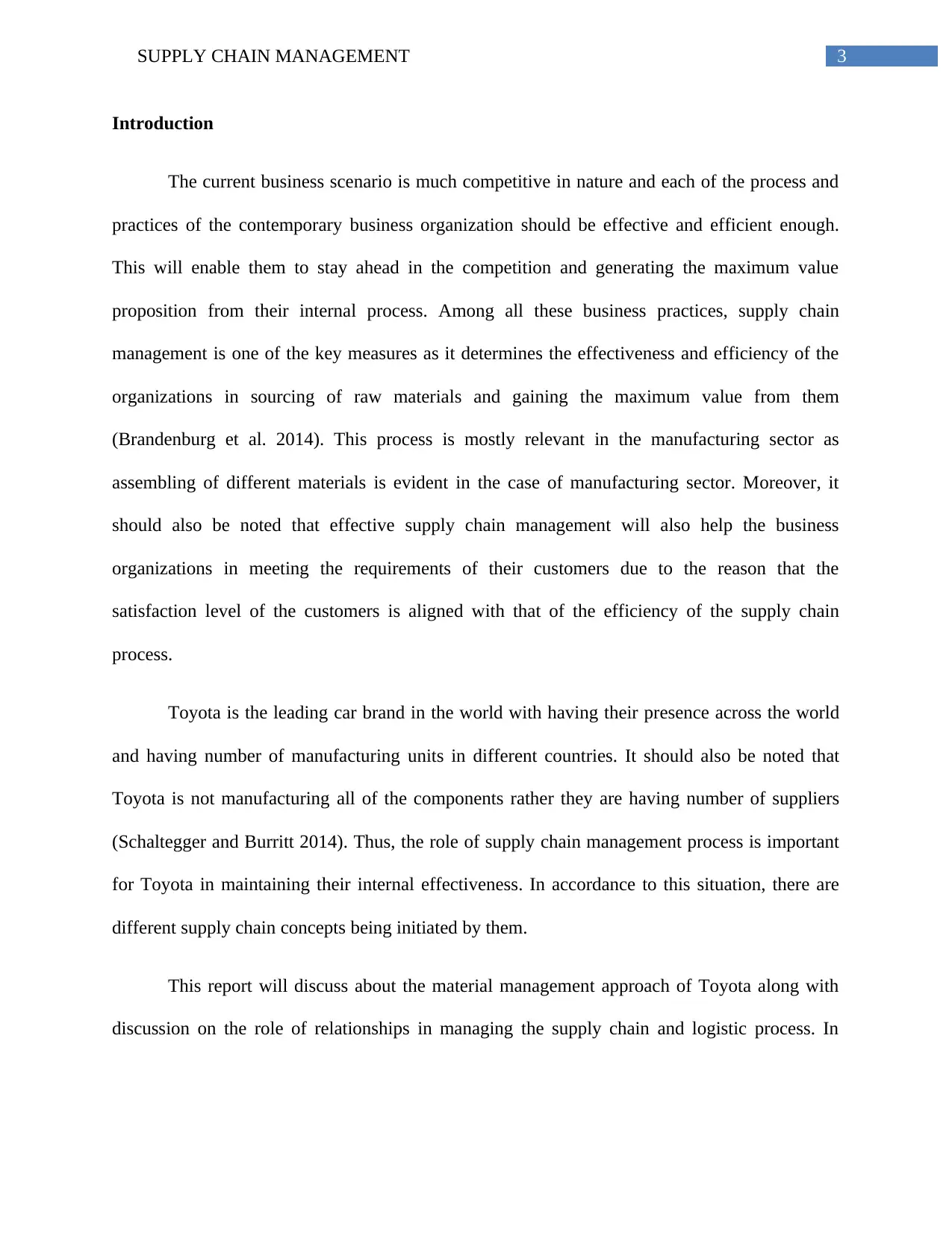
3SUPPLY CHAIN MANAGEMENT
Introduction
The current business scenario is much competitive in nature and each of the process and
practices of the contemporary business organization should be effective and efficient enough.
This will enable them to stay ahead in the competition and generating the maximum value
proposition from their internal process. Among all these business practices, supply chain
management is one of the key measures as it determines the effectiveness and efficiency of the
organizations in sourcing of raw materials and gaining the maximum value from them
(Brandenburg et al. 2014). This process is mostly relevant in the manufacturing sector as
assembling of different materials is evident in the case of manufacturing sector. Moreover, it
should also be noted that effective supply chain management will also help the business
organizations in meeting the requirements of their customers due to the reason that the
satisfaction level of the customers is aligned with that of the efficiency of the supply chain
process.
Toyota is the leading car brand in the world with having their presence across the world
and having number of manufacturing units in different countries. It should also be noted that
Toyota is not manufacturing all of the components rather they are having number of suppliers
(Schaltegger and Burritt 2014). Thus, the role of supply chain management process is important
for Toyota in maintaining their internal effectiveness. In accordance to this situation, there are
different supply chain concepts being initiated by them.
This report will discuss about the material management approach of Toyota along with
discussion on the role of relationships in managing the supply chain and logistic process. In
Introduction
The current business scenario is much competitive in nature and each of the process and
practices of the contemporary business organization should be effective and efficient enough.
This will enable them to stay ahead in the competition and generating the maximum value
proposition from their internal process. Among all these business practices, supply chain
management is one of the key measures as it determines the effectiveness and efficiency of the
organizations in sourcing of raw materials and gaining the maximum value from them
(Brandenburg et al. 2014). This process is mostly relevant in the manufacturing sector as
assembling of different materials is evident in the case of manufacturing sector. Moreover, it
should also be noted that effective supply chain management will also help the business
organizations in meeting the requirements of their customers due to the reason that the
satisfaction level of the customers is aligned with that of the efficiency of the supply chain
process.
Toyota is the leading car brand in the world with having their presence across the world
and having number of manufacturing units in different countries. It should also be noted that
Toyota is not manufacturing all of the components rather they are having number of suppliers
(Schaltegger and Burritt 2014). Thus, the role of supply chain management process is important
for Toyota in maintaining their internal effectiveness. In accordance to this situation, there are
different supply chain concepts being initiated by them.
This report will discuss about the material management approach of Toyota along with
discussion on the role of relationships in managing the supply chain and logistic process. In
Paraphrase This Document
Need a fresh take? Get an instant paraphrase of this document with our AI Paraphraser
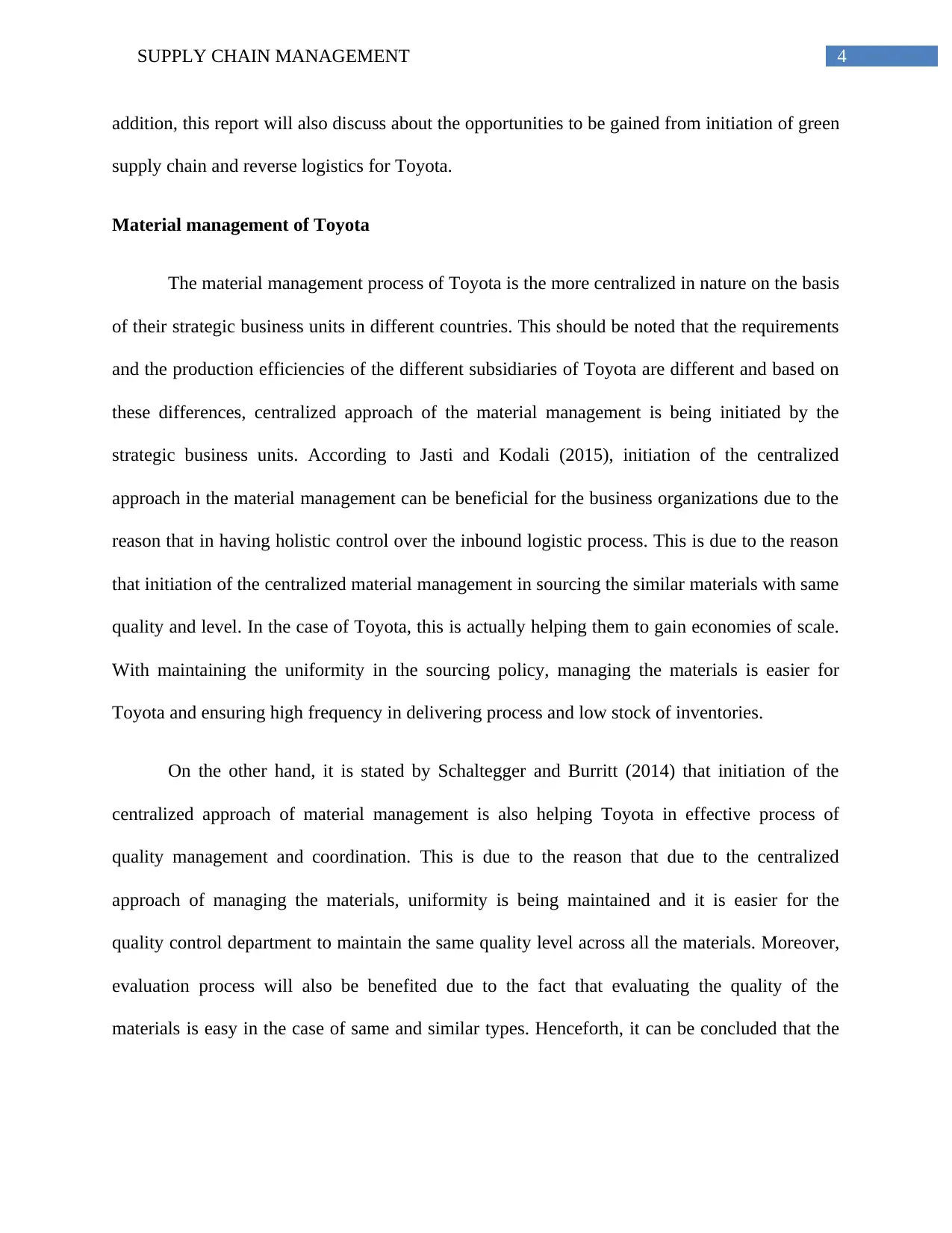
4SUPPLY CHAIN MANAGEMENT
addition, this report will also discuss about the opportunities to be gained from initiation of green
supply chain and reverse logistics for Toyota.
Material management of Toyota
The material management process of Toyota is the more centralized in nature on the basis
of their strategic business units in different countries. This should be noted that the requirements
and the production efficiencies of the different subsidiaries of Toyota are different and based on
these differences, centralized approach of the material management is being initiated by the
strategic business units. According to Jasti and Kodali (2015), initiation of the centralized
approach in the material management can be beneficial for the business organizations due to the
reason that in having holistic control over the inbound logistic process. This is due to the reason
that initiation of the centralized material management in sourcing the similar materials with same
quality and level. In the case of Toyota, this is actually helping them to gain economies of scale.
With maintaining the uniformity in the sourcing policy, managing the materials is easier for
Toyota and ensuring high frequency in delivering process and low stock of inventories.
On the other hand, it is stated by Schaltegger and Burritt (2014) that initiation of the
centralized approach of material management is also helping Toyota in effective process of
quality management and coordination. This is due to the reason that due to the centralized
approach of managing the materials, uniformity is being maintained and it is easier for the
quality control department to maintain the same quality level across all the materials. Moreover,
evaluation process will also be benefited due to the fact that evaluating the quality of the
materials is easy in the case of same and similar types. Henceforth, it can be concluded that the
addition, this report will also discuss about the opportunities to be gained from initiation of green
supply chain and reverse logistics for Toyota.
Material management of Toyota
The material management process of Toyota is the more centralized in nature on the basis
of their strategic business units in different countries. This should be noted that the requirements
and the production efficiencies of the different subsidiaries of Toyota are different and based on
these differences, centralized approach of the material management is being initiated by the
strategic business units. According to Jasti and Kodali (2015), initiation of the centralized
approach in the material management can be beneficial for the business organizations due to the
reason that in having holistic control over the inbound logistic process. This is due to the reason
that initiation of the centralized material management in sourcing the similar materials with same
quality and level. In the case of Toyota, this is actually helping them to gain economies of scale.
With maintaining the uniformity in the sourcing policy, managing the materials is easier for
Toyota and ensuring high frequency in delivering process and low stock of inventories.
On the other hand, it is stated by Schaltegger and Burritt (2014) that initiation of the
centralized approach of material management is also helping Toyota in effective process of
quality management and coordination. This is due to the reason that due to the centralized
approach of managing the materials, uniformity is being maintained and it is easier for the
quality control department to maintain the same quality level across all the materials. Moreover,
evaluation process will also be benefited due to the fact that evaluating the quality of the
materials is easy in the case of same and similar types. Henceforth, it can be concluded that the
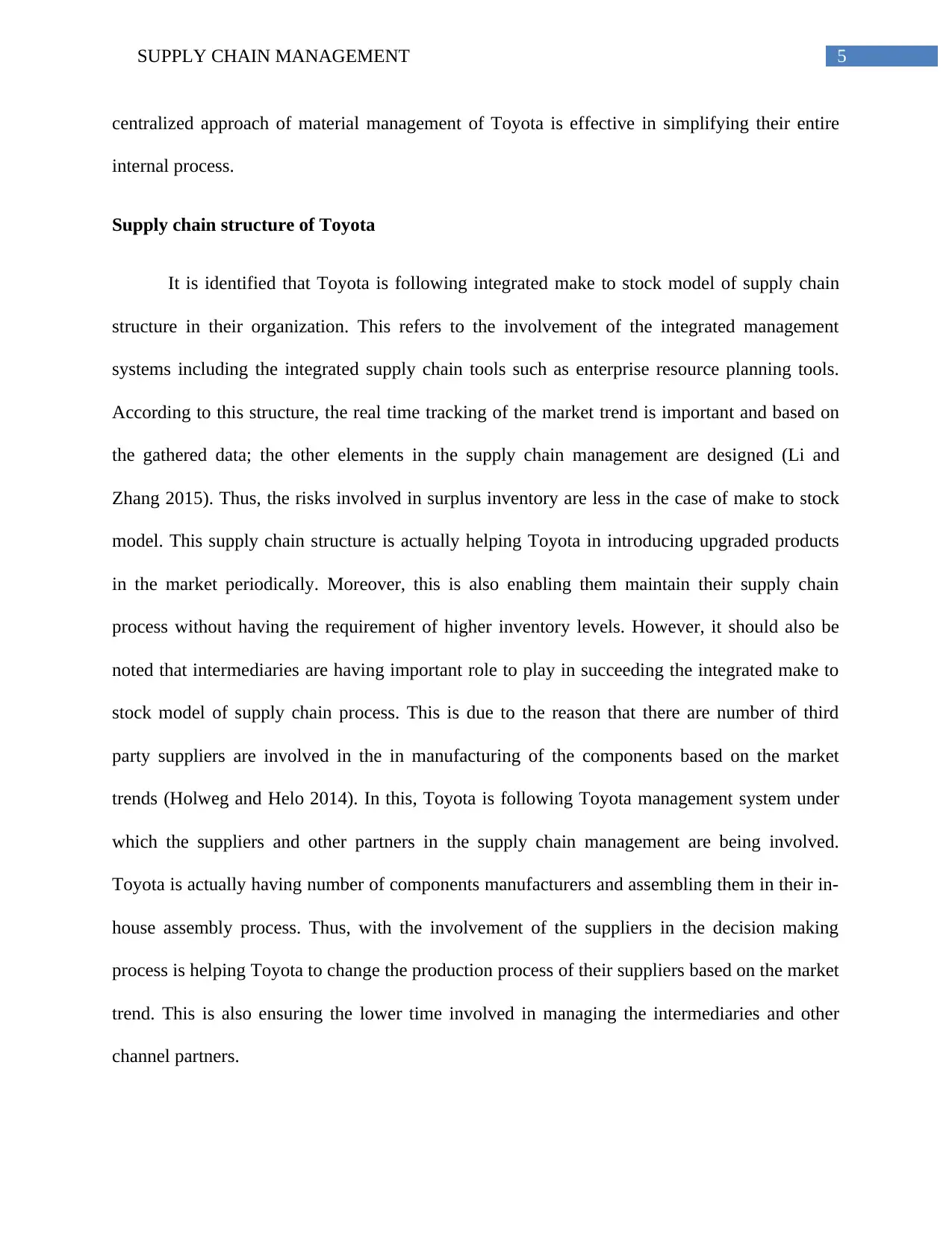
5SUPPLY CHAIN MANAGEMENT
centralized approach of material management of Toyota is effective in simplifying their entire
internal process.
Supply chain structure of Toyota
It is identified that Toyota is following integrated make to stock model of supply chain
structure in their organization. This refers to the involvement of the integrated management
systems including the integrated supply chain tools such as enterprise resource planning tools.
According to this structure, the real time tracking of the market trend is important and based on
the gathered data; the other elements in the supply chain management are designed (Li and
Zhang 2015). Thus, the risks involved in surplus inventory are less in the case of make to stock
model. This supply chain structure is actually helping Toyota in introducing upgraded products
in the market periodically. Moreover, this is also enabling them maintain their supply chain
process without having the requirement of higher inventory levels. However, it should also be
noted that intermediaries are having important role to play in succeeding the integrated make to
stock model of supply chain process. This is due to the reason that there are number of third
party suppliers are involved in the in manufacturing of the components based on the market
trends (Holweg and Helo 2014). In this, Toyota is following Toyota management system under
which the suppliers and other partners in the supply chain management are being involved.
Toyota is actually having number of components manufacturers and assembling them in their in-
house assembly process. Thus, with the involvement of the suppliers in the decision making
process is helping Toyota to change the production process of their suppliers based on the market
trend. This is also ensuring the lower time involved in managing the intermediaries and other
channel partners.
centralized approach of material management of Toyota is effective in simplifying their entire
internal process.
Supply chain structure of Toyota
It is identified that Toyota is following integrated make to stock model of supply chain
structure in their organization. This refers to the involvement of the integrated management
systems including the integrated supply chain tools such as enterprise resource planning tools.
According to this structure, the real time tracking of the market trend is important and based on
the gathered data; the other elements in the supply chain management are designed (Li and
Zhang 2015). Thus, the risks involved in surplus inventory are less in the case of make to stock
model. This supply chain structure is actually helping Toyota in introducing upgraded products
in the market periodically. Moreover, this is also enabling them maintain their supply chain
process without having the requirement of higher inventory levels. However, it should also be
noted that intermediaries are having important role to play in succeeding the integrated make to
stock model of supply chain process. This is due to the reason that there are number of third
party suppliers are involved in the in manufacturing of the components based on the market
trends (Holweg and Helo 2014). In this, Toyota is following Toyota management system under
which the suppliers and other partners in the supply chain management are being involved.
Toyota is actually having number of components manufacturers and assembling them in their in-
house assembly process. Thus, with the involvement of the suppliers in the decision making
process is helping Toyota to change the production process of their suppliers based on the market
trend. This is also ensuring the lower time involved in managing the intermediaries and other
channel partners.
⊘ This is a preview!⊘
Do you want full access?
Subscribe today to unlock all pages.

Trusted by 1+ million students worldwide

6SUPPLY CHAIN MANAGEMENT
Advantages of lean and agile practices
There are number of advantages that can be gained by Toyota by promoting the lean and
agile practices in their supply chain process. With the help of the lean practices, the inventory
holding rate can be further reduced by them. Thus, the lower will be the requirement for
maintaining inventory in the supply chain management; the less will be the involved risks in
managing inventories (Dues, Tan and Lim 2013). Moreover, Toyota will also gain advantages in
terms of involvement of lower fund invested in the inventories. With the involvement of lower
sets of inventories, Toyota will have larger flexibility in terms of changing the supply chain
designs. On the other hand, initiation of the lean practices will also ensure the enhancement of
the employee performance. This is due to the reason that lean practices also involve the efficient
human resource performance. Hence, the competitive advantages to be gained from the human
resources will also be relevant for Toyota (Govindan et al. 2015).
On the other hand, initiation of the agile practices will further enable Toyota in gaining
flexibility in their supply chain process. This is due to the reason that the more will be the agility
of the supply chain process, the more will be their effectiveness in coping up to the change in the
external environment and designs it accordingly (Qrunfleh and Tarafdar 2013). In this case, the
existing policies of Toyota such as just in time approach can contribute to the promotion of the
agile practices. This is due to the reason that with the help of the just in time approaches, Toyota
is holding lower sets of inventories at any point of time and thus it is easier for them to change
their production approach without having the risks for wastages. With the help of the agile
practices, Toyota will gain the competitive advantages in terms of introducing latest products in
the market with minimal given time.
Advantages of lean and agile practices
There are number of advantages that can be gained by Toyota by promoting the lean and
agile practices in their supply chain process. With the help of the lean practices, the inventory
holding rate can be further reduced by them. Thus, the lower will be the requirement for
maintaining inventory in the supply chain management; the less will be the involved risks in
managing inventories (Dues, Tan and Lim 2013). Moreover, Toyota will also gain advantages in
terms of involvement of lower fund invested in the inventories. With the involvement of lower
sets of inventories, Toyota will have larger flexibility in terms of changing the supply chain
designs. On the other hand, initiation of the lean practices will also ensure the enhancement of
the employee performance. This is due to the reason that lean practices also involve the efficient
human resource performance. Hence, the competitive advantages to be gained from the human
resources will also be relevant for Toyota (Govindan et al. 2015).
On the other hand, initiation of the agile practices will further enable Toyota in gaining
flexibility in their supply chain process. This is due to the reason that the more will be the agility
of the supply chain process, the more will be their effectiveness in coping up to the change in the
external environment and designs it accordingly (Qrunfleh and Tarafdar 2013). In this case, the
existing policies of Toyota such as just in time approach can contribute to the promotion of the
agile practices. This is due to the reason that with the help of the just in time approaches, Toyota
is holding lower sets of inventories at any point of time and thus it is easier for them to change
their production approach without having the risks for wastages. With the help of the agile
practices, Toyota will gain the competitive advantages in terms of introducing latest products in
the market with minimal given time.
Paraphrase This Document
Need a fresh take? Get an instant paraphrase of this document with our AI Paraphraser
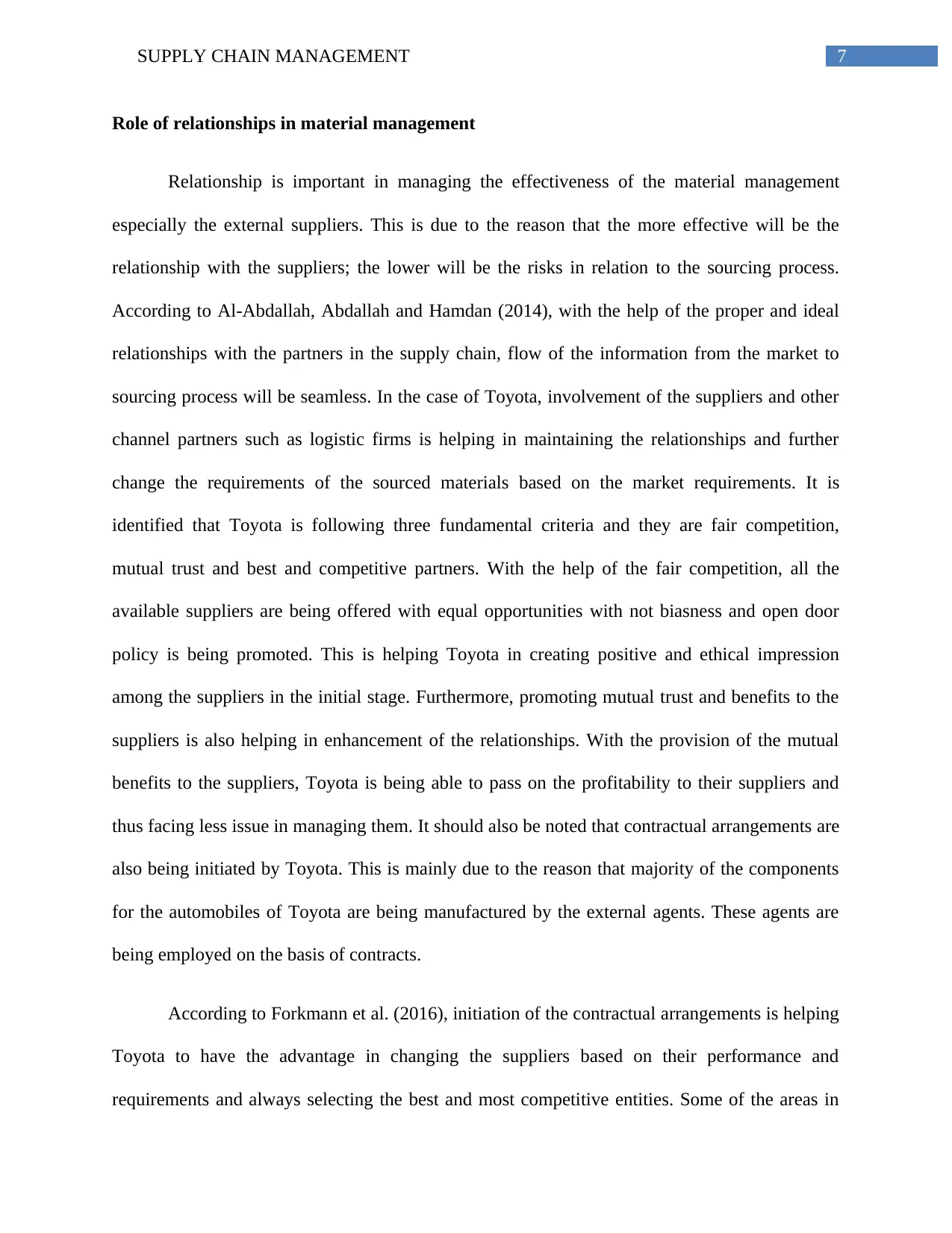
7SUPPLY CHAIN MANAGEMENT
Role of relationships in material management
Relationship is important in managing the effectiveness of the material management
especially the external suppliers. This is due to the reason that the more effective will be the
relationship with the suppliers; the lower will be the risks in relation to the sourcing process.
According to Al-Abdallah, Abdallah and Hamdan (2014), with the help of the proper and ideal
relationships with the partners in the supply chain, flow of the information from the market to
sourcing process will be seamless. In the case of Toyota, involvement of the suppliers and other
channel partners such as logistic firms is helping in maintaining the relationships and further
change the requirements of the sourced materials based on the market requirements. It is
identified that Toyota is following three fundamental criteria and they are fair competition,
mutual trust and best and competitive partners. With the help of the fair competition, all the
available suppliers are being offered with equal opportunities with not biasness and open door
policy is being promoted. This is helping Toyota in creating positive and ethical impression
among the suppliers in the initial stage. Furthermore, promoting mutual trust and benefits to the
suppliers is also helping in enhancement of the relationships. With the provision of the mutual
benefits to the suppliers, Toyota is being able to pass on the profitability to their suppliers and
thus facing less issue in managing them. It should also be noted that contractual arrangements are
also being initiated by Toyota. This is mainly due to the reason that majority of the components
for the automobiles of Toyota are being manufactured by the external agents. These agents are
being employed on the basis of contracts.
According to Forkmann et al. (2016), initiation of the contractual arrangements is helping
Toyota to have the advantage in changing the suppliers based on their performance and
requirements and always selecting the best and most competitive entities. Some of the areas in
Role of relationships in material management
Relationship is important in managing the effectiveness of the material management
especially the external suppliers. This is due to the reason that the more effective will be the
relationship with the suppliers; the lower will be the risks in relation to the sourcing process.
According to Al-Abdallah, Abdallah and Hamdan (2014), with the help of the proper and ideal
relationships with the partners in the supply chain, flow of the information from the market to
sourcing process will be seamless. In the case of Toyota, involvement of the suppliers and other
channel partners such as logistic firms is helping in maintaining the relationships and further
change the requirements of the sourced materials based on the market requirements. It is
identified that Toyota is following three fundamental criteria and they are fair competition,
mutual trust and best and competitive partners. With the help of the fair competition, all the
available suppliers are being offered with equal opportunities with not biasness and open door
policy is being promoted. This is helping Toyota in creating positive and ethical impression
among the suppliers in the initial stage. Furthermore, promoting mutual trust and benefits to the
suppliers is also helping in enhancement of the relationships. With the provision of the mutual
benefits to the suppliers, Toyota is being able to pass on the profitability to their suppliers and
thus facing less issue in managing them. It should also be noted that contractual arrangements are
also being initiated by Toyota. This is mainly due to the reason that majority of the components
for the automobiles of Toyota are being manufactured by the external agents. These agents are
being employed on the basis of contracts.
According to Forkmann et al. (2016), initiation of the contractual arrangements is helping
Toyota to have the advantage in changing the suppliers based on their performance and
requirements and always selecting the best and most competitive entities. Some of the areas in
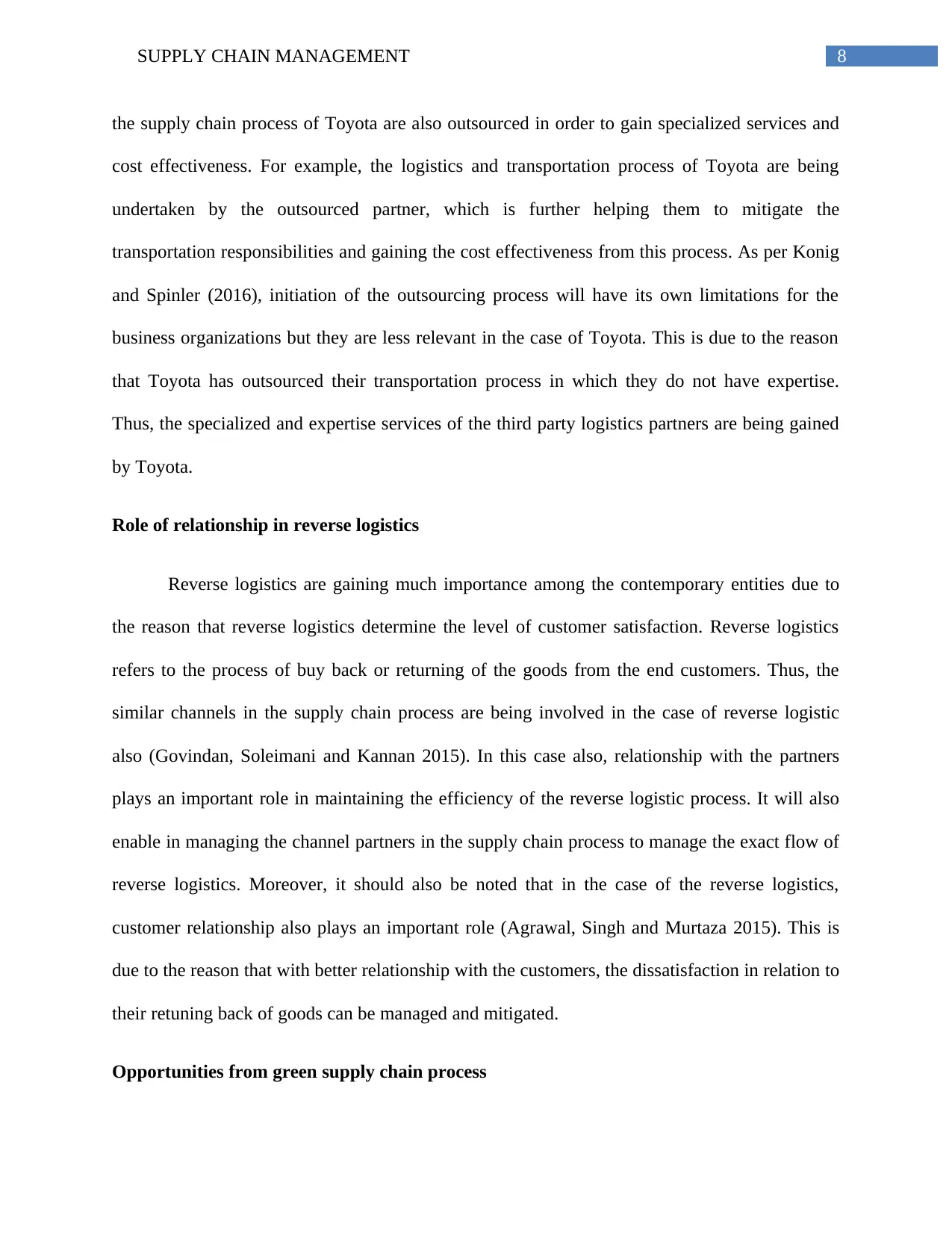
8SUPPLY CHAIN MANAGEMENT
the supply chain process of Toyota are also outsourced in order to gain specialized services and
cost effectiveness. For example, the logistics and transportation process of Toyota are being
undertaken by the outsourced partner, which is further helping them to mitigate the
transportation responsibilities and gaining the cost effectiveness from this process. As per Konig
and Spinler (2016), initiation of the outsourcing process will have its own limitations for the
business organizations but they are less relevant in the case of Toyota. This is due to the reason
that Toyota has outsourced their transportation process in which they do not have expertise.
Thus, the specialized and expertise services of the third party logistics partners are being gained
by Toyota.
Role of relationship in reverse logistics
Reverse logistics are gaining much importance among the contemporary entities due to
the reason that reverse logistics determine the level of customer satisfaction. Reverse logistics
refers to the process of buy back or returning of the goods from the end customers. Thus, the
similar channels in the supply chain process are being involved in the case of reverse logistic
also (Govindan, Soleimani and Kannan 2015). In this case also, relationship with the partners
plays an important role in maintaining the efficiency of the reverse logistic process. It will also
enable in managing the channel partners in the supply chain process to manage the exact flow of
reverse logistics. Moreover, it should also be noted that in the case of the reverse logistics,
customer relationship also plays an important role (Agrawal, Singh and Murtaza 2015). This is
due to the reason that with better relationship with the customers, the dissatisfaction in relation to
their retuning back of goods can be managed and mitigated.
Opportunities from green supply chain process
the supply chain process of Toyota are also outsourced in order to gain specialized services and
cost effectiveness. For example, the logistics and transportation process of Toyota are being
undertaken by the outsourced partner, which is further helping them to mitigate the
transportation responsibilities and gaining the cost effectiveness from this process. As per Konig
and Spinler (2016), initiation of the outsourcing process will have its own limitations for the
business organizations but they are less relevant in the case of Toyota. This is due to the reason
that Toyota has outsourced their transportation process in which they do not have expertise.
Thus, the specialized and expertise services of the third party logistics partners are being gained
by Toyota.
Role of relationship in reverse logistics
Reverse logistics are gaining much importance among the contemporary entities due to
the reason that reverse logistics determine the level of customer satisfaction. Reverse logistics
refers to the process of buy back or returning of the goods from the end customers. Thus, the
similar channels in the supply chain process are being involved in the case of reverse logistic
also (Govindan, Soleimani and Kannan 2015). In this case also, relationship with the partners
plays an important role in maintaining the efficiency of the reverse logistic process. It will also
enable in managing the channel partners in the supply chain process to manage the exact flow of
reverse logistics. Moreover, it should also be noted that in the case of the reverse logistics,
customer relationship also plays an important role (Agrawal, Singh and Murtaza 2015). This is
due to the reason that with better relationship with the customers, the dissatisfaction in relation to
their retuning back of goods can be managed and mitigated.
Opportunities from green supply chain process
⊘ This is a preview!⊘
Do you want full access?
Subscribe today to unlock all pages.

Trusted by 1+ million students worldwide
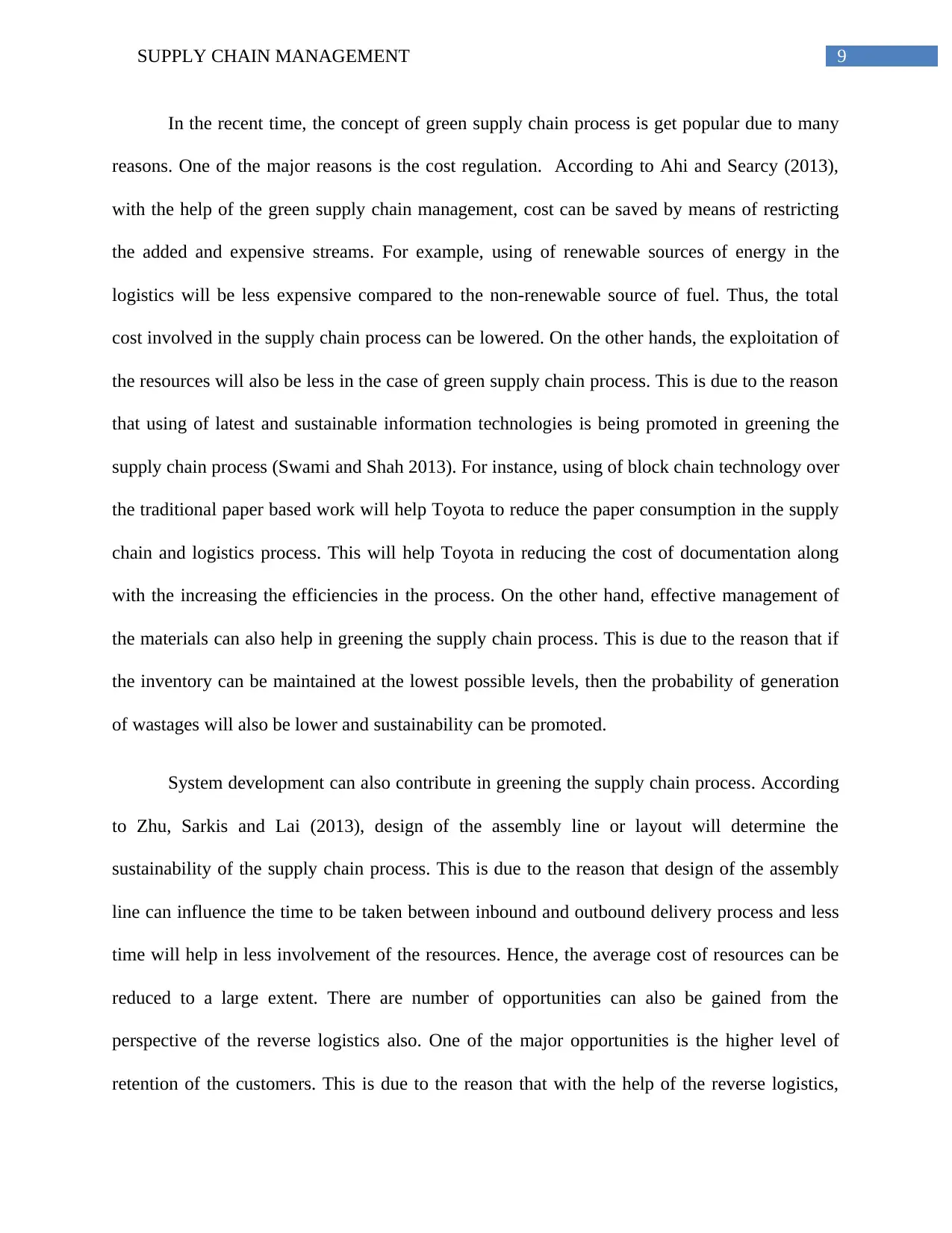
9SUPPLY CHAIN MANAGEMENT
In the recent time, the concept of green supply chain process is get popular due to many
reasons. One of the major reasons is the cost regulation. According to Ahi and Searcy (2013),
with the help of the green supply chain management, cost can be saved by means of restricting
the added and expensive streams. For example, using of renewable sources of energy in the
logistics will be less expensive compared to the non-renewable source of fuel. Thus, the total
cost involved in the supply chain process can be lowered. On the other hands, the exploitation of
the resources will also be less in the case of green supply chain process. This is due to the reason
that using of latest and sustainable information technologies is being promoted in greening the
supply chain process (Swami and Shah 2013). For instance, using of block chain technology over
the traditional paper based work will help Toyota to reduce the paper consumption in the supply
chain and logistics process. This will help Toyota in reducing the cost of documentation along
with the increasing the efficiencies in the process. On the other hand, effective management of
the materials can also help in greening the supply chain process. This is due to the reason that if
the inventory can be maintained at the lowest possible levels, then the probability of generation
of wastages will also be lower and sustainability can be promoted.
System development can also contribute in greening the supply chain process. According
to Zhu, Sarkis and Lai (2013), design of the assembly line or layout will determine the
sustainability of the supply chain process. This is due to the reason that design of the assembly
line can influence the time to be taken between inbound and outbound delivery process and less
time will help in less involvement of the resources. Hence, the average cost of resources can be
reduced to a large extent. There are number of opportunities can also be gained from the
perspective of the reverse logistics also. One of the major opportunities is the higher level of
retention of the customers. This is due to the reason that with the help of the reverse logistics,
In the recent time, the concept of green supply chain process is get popular due to many
reasons. One of the major reasons is the cost regulation. According to Ahi and Searcy (2013),
with the help of the green supply chain management, cost can be saved by means of restricting
the added and expensive streams. For example, using of renewable sources of energy in the
logistics will be less expensive compared to the non-renewable source of fuel. Thus, the total
cost involved in the supply chain process can be lowered. On the other hands, the exploitation of
the resources will also be less in the case of green supply chain process. This is due to the reason
that using of latest and sustainable information technologies is being promoted in greening the
supply chain process (Swami and Shah 2013). For instance, using of block chain technology over
the traditional paper based work will help Toyota to reduce the paper consumption in the supply
chain and logistics process. This will help Toyota in reducing the cost of documentation along
with the increasing the efficiencies in the process. On the other hand, effective management of
the materials can also help in greening the supply chain process. This is due to the reason that if
the inventory can be maintained at the lowest possible levels, then the probability of generation
of wastages will also be lower and sustainability can be promoted.
System development can also contribute in greening the supply chain process. According
to Zhu, Sarkis and Lai (2013), design of the assembly line or layout will determine the
sustainability of the supply chain process. This is due to the reason that design of the assembly
line can influence the time to be taken between inbound and outbound delivery process and less
time will help in less involvement of the resources. Hence, the average cost of resources can be
reduced to a large extent. There are number of opportunities can also be gained from the
perspective of the reverse logistics also. One of the major opportunities is the higher level of
retention of the customers. This is due to the reason that with the help of the reverse logistics,
Paraphrase This Document
Need a fresh take? Get an instant paraphrase of this document with our AI Paraphraser
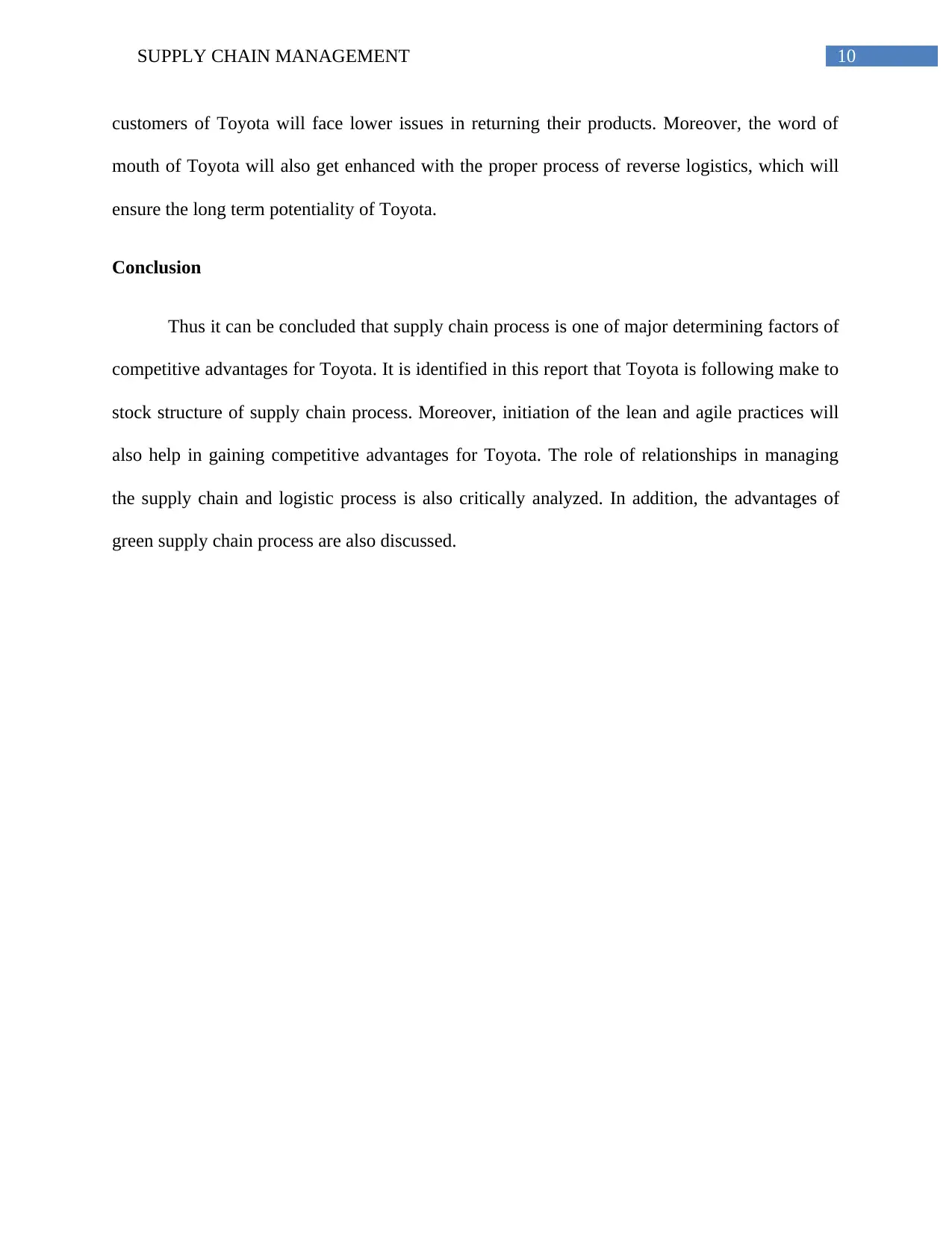
10SUPPLY CHAIN MANAGEMENT
customers of Toyota will face lower issues in returning their products. Moreover, the word of
mouth of Toyota will also get enhanced with the proper process of reverse logistics, which will
ensure the long term potentiality of Toyota.
Conclusion
Thus it can be concluded that supply chain process is one of major determining factors of
competitive advantages for Toyota. It is identified in this report that Toyota is following make to
stock structure of supply chain process. Moreover, initiation of the lean and agile practices will
also help in gaining competitive advantages for Toyota. The role of relationships in managing
the supply chain and logistic process is also critically analyzed. In addition, the advantages of
green supply chain process are also discussed.
customers of Toyota will face lower issues in returning their products. Moreover, the word of
mouth of Toyota will also get enhanced with the proper process of reverse logistics, which will
ensure the long term potentiality of Toyota.
Conclusion
Thus it can be concluded that supply chain process is one of major determining factors of
competitive advantages for Toyota. It is identified in this report that Toyota is following make to
stock structure of supply chain process. Moreover, initiation of the lean and agile practices will
also help in gaining competitive advantages for Toyota. The role of relationships in managing
the supply chain and logistic process is also critically analyzed. In addition, the advantages of
green supply chain process are also discussed.
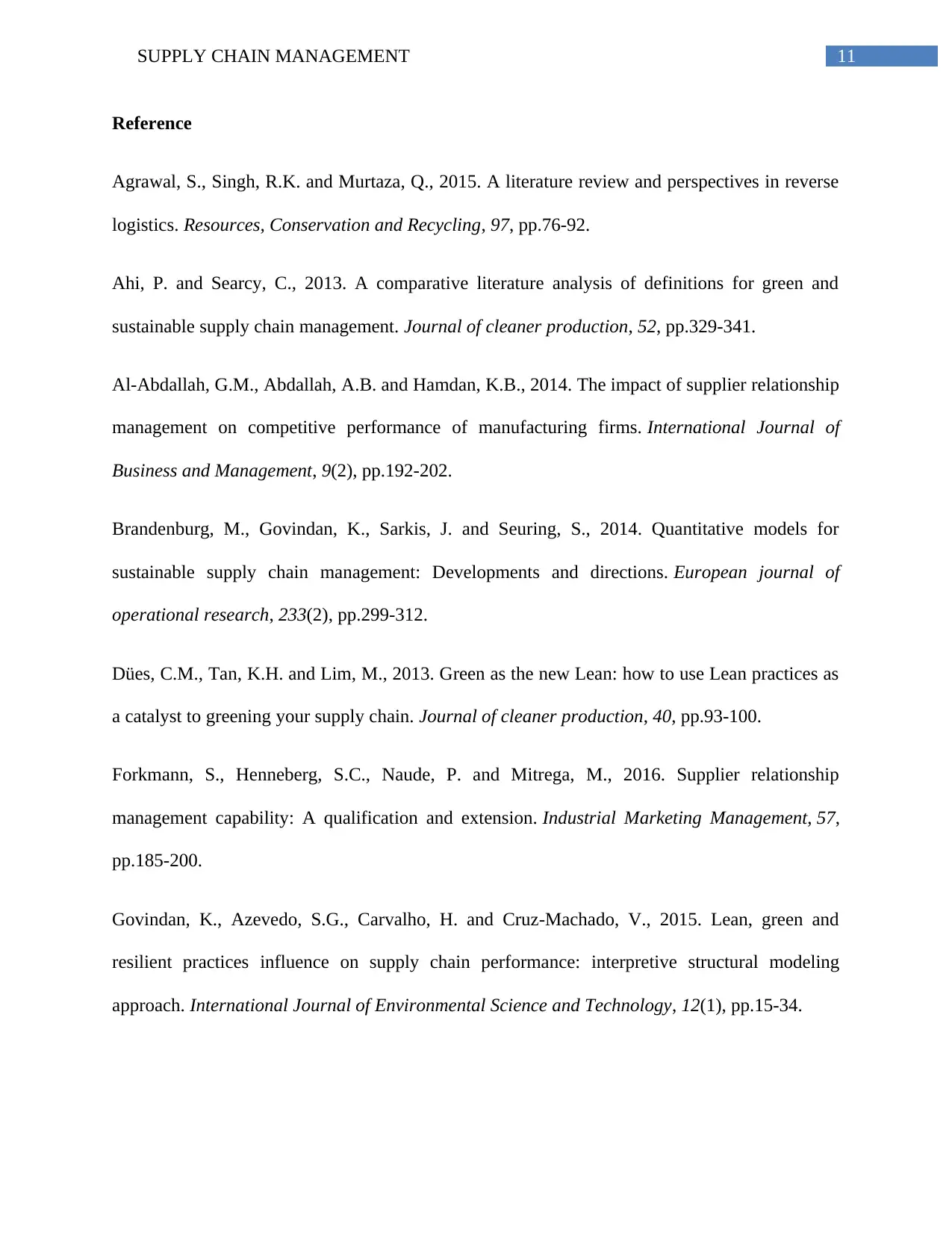
11SUPPLY CHAIN MANAGEMENT
Reference
Agrawal, S., Singh, R.K. and Murtaza, Q., 2015. A literature review and perspectives in reverse
logistics. Resources, Conservation and Recycling, 97, pp.76-92.
Ahi, P. and Searcy, C., 2013. A comparative literature analysis of definitions for green and
sustainable supply chain management. Journal of cleaner production, 52, pp.329-341.
Al-Abdallah, G.M., Abdallah, A.B. and Hamdan, K.B., 2014. The impact of supplier relationship
management on competitive performance of manufacturing firms. International Journal of
Business and Management, 9(2), pp.192-202.
Brandenburg, M., Govindan, K., Sarkis, J. and Seuring, S., 2014. Quantitative models for
sustainable supply chain management: Developments and directions. European journal of
operational research, 233(2), pp.299-312.
Dües, C.M., Tan, K.H. and Lim, M., 2013. Green as the new Lean: how to use Lean practices as
a catalyst to greening your supply chain. Journal of cleaner production, 40, pp.93-100.
Forkmann, S., Henneberg, S.C., Naude, P. and Mitrega, M., 2016. Supplier relationship
management capability: A qualification and extension. Industrial Marketing Management, 57,
pp.185-200.
Govindan, K., Azevedo, S.G., Carvalho, H. and Cruz-Machado, V., 2015. Lean, green and
resilient practices influence on supply chain performance: interpretive structural modeling
approach. International Journal of Environmental Science and Technology, 12(1), pp.15-34.
Reference
Agrawal, S., Singh, R.K. and Murtaza, Q., 2015. A literature review and perspectives in reverse
logistics. Resources, Conservation and Recycling, 97, pp.76-92.
Ahi, P. and Searcy, C., 2013. A comparative literature analysis of definitions for green and
sustainable supply chain management. Journal of cleaner production, 52, pp.329-341.
Al-Abdallah, G.M., Abdallah, A.B. and Hamdan, K.B., 2014. The impact of supplier relationship
management on competitive performance of manufacturing firms. International Journal of
Business and Management, 9(2), pp.192-202.
Brandenburg, M., Govindan, K., Sarkis, J. and Seuring, S., 2014. Quantitative models for
sustainable supply chain management: Developments and directions. European journal of
operational research, 233(2), pp.299-312.
Dües, C.M., Tan, K.H. and Lim, M., 2013. Green as the new Lean: how to use Lean practices as
a catalyst to greening your supply chain. Journal of cleaner production, 40, pp.93-100.
Forkmann, S., Henneberg, S.C., Naude, P. and Mitrega, M., 2016. Supplier relationship
management capability: A qualification and extension. Industrial Marketing Management, 57,
pp.185-200.
Govindan, K., Azevedo, S.G., Carvalho, H. and Cruz-Machado, V., 2015. Lean, green and
resilient practices influence on supply chain performance: interpretive structural modeling
approach. International Journal of Environmental Science and Technology, 12(1), pp.15-34.
⊘ This is a preview!⊘
Do you want full access?
Subscribe today to unlock all pages.

Trusted by 1+ million students worldwide
1 out of 14
Related Documents
Your All-in-One AI-Powered Toolkit for Academic Success.
+13062052269
info@desklib.com
Available 24*7 on WhatsApp / Email
![[object Object]](/_next/static/media/star-bottom.7253800d.svg)
Unlock your academic potential
Copyright © 2020–2025 A2Z Services. All Rights Reserved. Developed and managed by ZUCOL.





